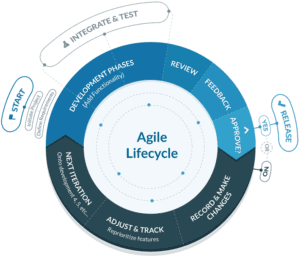Last updated on March 22nd, 2024 at 11:11 am
5 steps to implement agile hiring
What is agile hiring?
Agile is a concept borrowed from software development. Agile relies on the constant interchange of feedback between the stakeholders of the project. The feedback is used to identify shortcomings in the processes and eliminate them to obtain better outcomes.
 Analogously, agile hiring is aimed at being more cognizant of the needs of the organization and making the process more efficient.
Analogously, agile hiring is aimed at being more cognizant of the needs of the organization and making the process more efficient.
Agile hiring achieves this through continuous feedback and process improvement. Agile hiring is adopted to address talent shortages, reduce the length of the hiring processes, and enhance collaboration.
The agile hiring approach uses a framework of checkpoints and ‘sprints’ to ensure that the process remains on track.
What are the benefits of agile hiring?
Agile hiring enhances the efficiency of the hiring process, improves the quality of the hire, and also improves the candidate experience. The other benefits that accrue from agile hiring include:
- The process of continuous feedback, analysis, and decision-making based on data enables the refinement of the hiring process.
- It aids in lowering the cost per hire by enabling the efficient utilization of resources.
- Agile hiring affords the recruiters greater flexibility in being able to pivot promptly between possible tactics and strategies.
- It brings about greater focus among the members of the team by directing their attention to actions that aid the attainment of the targeted outcome.
- The culture of feedback inherent in agile hiring fosters an attitude of collaboration and open communication.
A Gartner study found that agile hiring reduces the cost per hire by 37%, reduces time to fill roles by 22%, and increases recruiter productivity by 31%.
The 5 steps in agile hiring
As discussed, agile hiring is an iterative process. The steps that make up agile hiring include:
- Defining the job requirement. This is probably the most important step in the agile hiring process. The concerned stakeholders (hiring manager, recruitment manager, etc.), after the need for hiring has been established, should outline, precisely, the requirements of the position and define the expectations from the position.
- Put the team together. Once the attributes of the person to be hired have been established, the next step involves putting together a team to undertake the hiring. Within this team, responsibilities should be clearly delineated and the details of the process and the targeted outcomes disseminated to all the members of the team. This will ensure a common understanding of the task and obviate any possibility of confusion during the periodic feedback and review meetings.
- Attract candidates. This activity encompasses several tasks – such as defining the job description, releasing the hiring ads, and identifying and contacting passive candidates. As each task is completed, collect feedback, review progress, and assess the quality of the applicants. If the applicant quality does not meet targeted requirements, the outreach strategy should be suitably modified.
- Candidate screening and interviewing. In this step, received applications are shortlisted, and preliminary interviews are scheduled with the shortlisted candidates. If the pool of candidates does not meet expectations, this is another opportunity to change the messaging and candidate sourcing channels.
- Candidate selection/rejection. At this stage of the hiring process, shortlisted candidates fitting the job criteria are interviewed to select the best person for the position. Like every step, this step is also used to review the sourcing and screening process. If at the end of this step a final offer letter is issued, it signals the end of the hiring. If not, then steps 3,4,5 are repeated and the process refined further to attain the desired outcome.
Final Thoughts
In agile hiring, final candidate selection does not signal the end of the process. The process is closed only after the candidate’s performance has been evaluated after a reasonable amount of time and his/her fit into the organization has been assessed. The purpose of this assessment is to assess the efficacy of the hiring process and identify areas for improvement.
Imarticus Learning specializes in empowering a new generation of professionals. Our learning programs practice agile corporate training, aimed at shortening the training duration without sacrificing training efficacy. We work through a dedicated account manager, for superior B2B account management so that our clients have a friction-free training experience.

